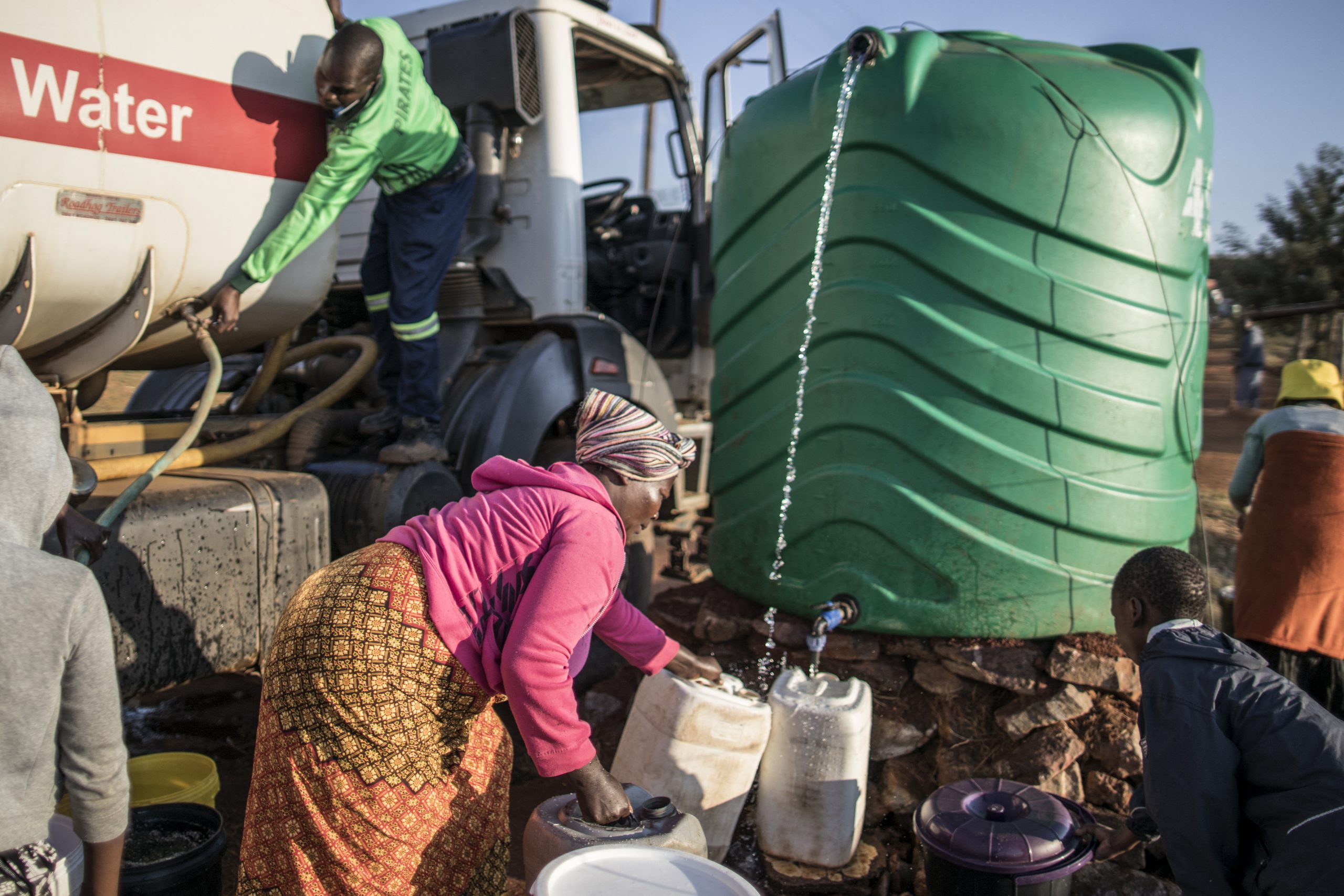South Africa is grappling with myriad challenges to its water security — droughts, inadequate water conservation measures, outdated infrastructure, and unequal access to water resources. The country faces significant water scarcity, with demand expected to surpass supply by 2030 by a projected gap of 17%.
This scarcity affects economic sectors such as agriculture, industry, energy generation and ecosystems, leading to reduced output, environmental degradation, and biodiversity loss.

Residents of the sprawling informal settlement on the outskirts of Lawley, Johannesburg, fill their buckets and containers at a water truck sent by the municipality to fill up the water tanks. Photo by MARCO LONGARI/AFP
Impure water contributes to waterborne diseases and strains public healthcare services, disproportionately affecting marginalised people and perpetuating social disparities. Women in rural areas, for instance, bear the brunt of water collection duties.
Addressing water scarcity is vital for breaking cycles of poverty, as time spent on water-related tasks results in lost economic opportunities. With climate change and population growth exacerbating the situation, effective governance of water resources is crucial for South Africa’s development.
Water insecurity stems from multiple key factors.
First, climatic causes contribute significantly, with the country experiencing lower-than-average precipitation levels, along with more erratic rainfall patterns, flooding, and prolonged drought.
Second, population growth leads to increased water demand, especially for domestic use, and highlights the need for expanded water infrastructure.
Third, natural resource management problems abound, including invasive species, siltation, and wetland degradation, which further strain water resources by reducing storage capacity and water quality.
Fourth, the energy sector’s reliance on coal exacerbates water shortages because coal-based energy production requires substantial water usage. This is an often overlooked factor in the water policy conversation; the preservation of jobs in the coal industry tends to be prioritised in the absence of understanding the negative externalities associated with coal, such as the effect on water quality and availability.
Finally, poor governance exacerbates water management problems, leading to mismanagement, inequitable distribution and infrastructure failures, as evidenced by the Hammanskraal cholera outbreak, partly caused by neglected sewage treatment works.
Addressing these factors is crucial for ensuring water security and sustainable development in South Africa.

South Africa’s water infrastructure is inadequate, despite its relatively extensive reach. Although many households have access to tap water, some still rely on alternative sources because of infrastructure problems, leading to dissatisfaction with water services and protests.
The Johannesburg and Durban water crisis, for example, has been ongoing for months, leaving residents without water for weeks and forcing others to drill boreholes (incurring an unplanned cost).
The South African Institute of Civil Engineering identifies significant risks to water infrastructure, with reactive maintenance practices shortening infrastructure lifespans. Ageing and poorly maintained infrastructure pose significant difficulties for the government.
Weak governance neglects maintenance, leading to poor engineering capacity. Although the budget is there to upgrade, some municipalities spend less than what is required to maintain their infrastructure. In fact, some of the better-resourced municipalities spend less than 1% of their budget on maintenance repairs.
The current delays in new infrastructure projects, such as the Lesotho Highlands Water Project Phase II and the Giyani water project, speak to poor governance and tender irregularities. The Lesotho project, for example, has been delayed by nine years, while the Giyani project has been delayed by 10 years and has ballooned from R90 million to R2 billion.
Urban areas have satisfactory infrastructure, but rural areas remain neglected, with substantial disparities in infrastructure delivery across provinces.
The majority of rural areas do not have water services because of the limited availability of water sources, administrative problems, and issues that relate to policy and political interference. In Limpopo, more than 20% of households do not have piped water, forcing many to use contaminated water from streams and rivers.
Non-revenue water, representing more than a third of water loss, highlights infrastructure inefficiencies exacerbated by limited engineering capacity. Gauteng loses 40% to 49% of its agricultural supply through non-revenue water, and up to 44% of drinking water through leakages.
Additionally, in most years, dam levels have remained low despite heavy rains, and many rivers are overexploited or in poor condition. Even when dam levels are high, they only provide temporary reprieve. In other words, full dams are a necessary but insufficient condition for water security in a water-scarce country.
Moreover, dams tend to have negative downstream effects on river health, such as altering the natural flow patterns and contributing to sediment buildup. Addressing these problems is crucial for ensuring water security and sustainable development in South Africa.
Dissatisfaction often stems from poorly governed, decentralised water service delivery, where municipalities lack financial resources and expertise. At the national level, fragmented coordination among multiple departments complicates regulation and supervision. The government has committed to addressing infrastructure problems through initiatives such as the National Water Resource Strategy, but its review process is overdue.
The Integrated Development Plan (IDP) framework aims to ensure coordination between government sectors and provide clean water for everyone in the country, but there’s a need to update water governance regulations to prioritise people’s needs over funding. Our policy briefing on “Enhancing IDPs to Improve Governance” speaks to the importance of using IDPs appropriately.
South Africa’s water resources are primarily governed by the National Water Act and the Water Services Act, which aim to ensure sustainable water consumption and access to safe drinking water. Regulatory frameworks enable the government to regulate household water usage and promote sustainability.
The Department of Water and Sanitation’s Drop reports, which assist in addressing problems in the water sector, have rather painted a gloomy picture of our state of water and the damage we are doing to our water systems.
The Blue Drop 2022-23 report (see illustration above) reflects poor performance by municipalities, noting that it was not “microbiologically safe to drink the water in almost half (46%) of our drinking water systems at times during 2022 when the Blue Drop audit was done”.
The latest Green Drop report also showed a deterioration in the performance of municipal wastewater treatment systems, with 64% of the treatment works at critical risk, as reflected above.
Based on the 2022–23 municipal financial year, the No Drop report notes a decline in water loss management practices in most of the municipalities. The assessment of our water systems, as seen in these reports, is important to ensure water meets its designated use and to improve its quality.
Communication and effective demand-reduction campaigns remain an integral part of resolving the water crisis. The participation of the public and raising awareness on using water efficiently is important to promoting ways of saving water, although it cannot be the only thing on which we depend.
To ensure sustainable water management, South Africa should promote water conservation through infrastructure repairs, and address the effects of climate change through risk assessments and adaptation plans.
The water and sanitation department must strengthen governance legislation, and ensure clear roles and enforcement, while government initiatives prioritise equitable access, especially in rural areas, to avoid infrastructure disparities.
Although South Africa is praised for its robust water consumption legislation and sustainability focus, problems arise as a result of inadequate implementation and poor governance. The lack of enforcement and management is concerning, particularly with 98% of available water already being used.
Despite having relatively developed water infrastructure, ongoing investments and effective governance efforts are necessary to address problems and ensure clean and reliable water for all people in the country.
Infrastructure degradation underscores the need for long-term policy and legislative measures to enhance accountability and maintenance. Government authorities can take progressive action by integrating water and sanitation knowledge and solutions into strategic service planning and delivery.
This article first appeared in Mail & Guardian.
Leleti Maluleke is a Researcher for our Human Security and Climate Change programme. She completed her Bachelor of Political Science in Political Studies in 2017, and her Honours in International Relations in 2018 at the University of Pretoria. She started her career at International SOS in the Security Services department as a Political Risk and Security Intern. Socially, her countries of interests include Mozambique, Zimbabwe, Zambia and Malawi.












